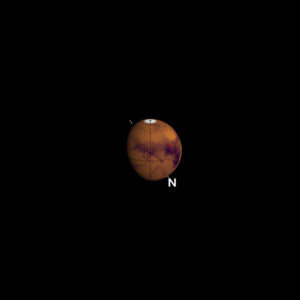With the Mars 2020 spacecraft on it way, I thought it would be good time to take a look at where its going. Actually, I couldn’t take any other useful images with a nearly full Moon. At these times the planets are the only targets that can reliably compete with the sky’s brightness.
This image was taken on the morning of 02 August when the Moon was 98% lit and Mars 86%.
The southern polar ice cap is obviously visible. The slightly brighter area in the upper right quadrant is the Hellas basin, reportedly the largest impact basin in the solar system. Below that is the dark Syrtis Major region that extends down past the equator. Jezero crater, the targeted landing site for the Perseverance rover, is all the way down the dark Syrtis Major formation on the left side of the point.
I am really looking forward to Mars’ 2020 opposition on the 13th of October. Right now Mars’ apparent angular size on the sky is 14.7 arc seconds. At opposition it will appear 22.3 arc seconds wide, a 51% increase in size.
For an explanation of caption information see exposure data.

